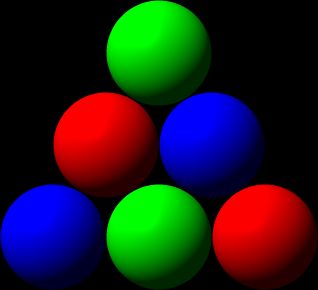第二题推出数学公式后发现太坑爹了。。
oblem Statement |
| |
A Ball Triangle is a set of identical balls placed in a triangular shape. A Ball Triangle has N rows, numbered 1 to N from top to bottom. For all i, 1 <= i <= N, the i-th row contains i balls. For example, the following image shows a Ball Triangle with N=3.

Fox Jiro has infinitely many Ball Triangles. He can paint a Ball Triangle according to the following conditions:
- Each of the balls has to be painted either red, green, or blue.
- No two adjacent balls may share the same color.
The following image shows one valid coloring of a Ball Triangle for N=3.

Jiro wants to paint as many Ball Triangles as he can. As long as he follows the rules above, he may color the Ball Triangles in any way he likes. Some of the colored Ball Triangles may look exactly the same, but they don't have to. The only other constraint is the total amount of paint available to Jiro: In all the triangles together, he can paint at most R balls red, G balls green, and B balls blue.
You are given the longs R, G, and B. You are also given the int N. Return the maximum possible number of Ball Triangles Jiro can paint. |
Definition |
| |
| Class: |
FoxPaintingBalls |
| Method: |
theMax |
| Parameters: |
long, long, long, int |
| Returns: |
long |
| Method signature: |
long theMax(long R, long G, long B, int N) |
| (be sure your method is public) |
|
| |
| |
Constraints |
| - |
R, G and B will each be between 0 and 1,000,000,000,000,000,000 (10^18), inclusive. |
| - |
N will be between 1 and 1,000,000,000, inclusive. |
Examples |
| 0) |
|
| |
|
|
Returns: 1 |
| Jiro can paint one Ball Triangle in the same way as in the image in the statement. |
|
|
| 1) |
|
| |
|
|
Returns: 0 |
| This time Jiro can paint no Ball Triangles. |
|
|
| 2) |
|
| |
|
| 3) |
|
| |
|
| 4) |
|
| |
|
| 5) |
|
| |
19330428391852493 |
48815737582834113 |
11451481019198930 |
3456 |
|
Returns: 5750952686 |
|
|
|
| 6) |
|
| |
|
This problem statement is the exclusive and proprietary property of TopCoder, Inc. Any unauthorized use or reproduction of this information without the prior written consent of TopCoder, Inc. is strictly prohibited. (c)2003, TopCoder, Inc. All rights reserved.
给出N求最多可以画多少?
一个规律
给出N,那么一共有M=N*(N+1)/2个球,那么画出一个满足目标的Triangle Ball需要的球的组合设为a个R球,b个G球,c个B球。
d=M/3; a,b,c就是和d接近的三个数。
如果M%3==0,那么a=b=c等于d,这样去R,G,B中最小的一个数除a就可以得到结果了。即return min(R,G,B)/a;
如果M%3==1或==2,设这一组数为d, d, d+1或者d+1,d+1,d。
a=b=d,c=d+1或者a=b=d+1,c=d。
因为a,b总相等,那么这一组数有3中排列方式。
(a,b,c)
(a,c,b)
(c,a,b)
设第一组使用了x个,第二组使用了y个,第三组使用了z个。
所求目标是max: x+y+z
注意,我们有
x*a+y*a+z*c=R
x*b+y*c+z*a=G
x*c+y*b+z*b=B
-----
左右相加,我们得到
x*(a+b+c)+y*(a+b+c)+z*(a+b+c)=R+G+B
整理,得到
(x+y+z)=(R+G+B)/(a+b+c)
所以x+y+z居然是固定的值!!
所以只要return (R+G+B)/(a+b+c)就可以了!
public class FoxPaintingBalls {
public long theMax(long R, long G, long B, int N){
long a, b, c;
long M=N*(N+1)/2;
long rm=M%3;
a=b=c=(M/3);
if(rm==1){
c++;
}
if(rm==2){
a++;
b++;
}
if(rm==0){
return Math.min(Math.min(R/a, G/a), B/a);
} else {
return (R+G+B)/(a+b+c);
}
}
}
如果没有注意到这个推倒而直接写一个递归函数的,就惨了,
像这样的。
private long getMax(long R, long G, long B, long a, long b, long c){
if((R==b&&G==a&&B==c)||(R==c&&G==b&&B==a)||(R==b&&G==c&&B==a)){
return 1;
}
else{
long x,y,z;
x=R-a;y=G-b;z=B-c;
long max1=0,max2=0,max3=0;
if(x>=0&&y>=0&&z>=0){
max1=getMax(x,y,z,a,b,c)+1;
}
x=R-a;y=G-c;z=B-b;
if(x>=0&&y>=0&&z>=0){
max2=getMax(x,y,z,a,b,c)+1;
}
x=R-c;y=G-a;z=B-b;
if(x>=0&&y>=0&&z>=0){
max3=getMax(x,y,z,a,b,c)+1;
}
return Math.max(Math.max(max1, max2), max3);
}
}

